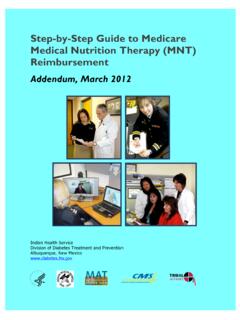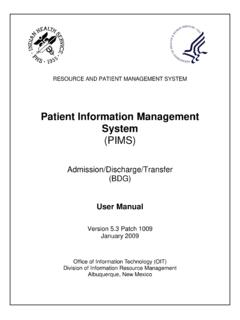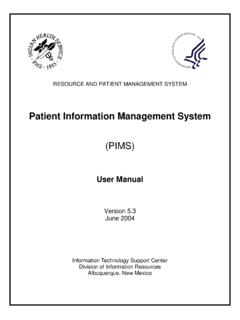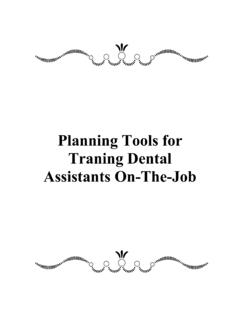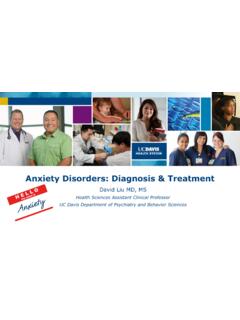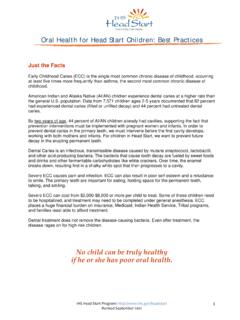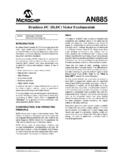Transcription of Buprenorphine for the Treatment of Opioid Use Disorders
1 Buprenorphine for the Treatment of Opioid Use Disorders Relevant Law / Standard: DATA 2000: Title XXXV, Section 3502 of the Children's Health Act of 2000. Policy and Purpose: This policy is intended to ensure appropriate assessment, management and monitoring of patients receiving office based Treatment with Buprenorphine for Opioid use Disorders . Overview Buprenorphine , a partial Opioid agonist, was approved by the FDA in 2002 for the Treatment of Opioid use disorder. Per the Drug Addiction Treatment Act of 2000, Buprenorphine can be prescribed outside the Narcotic Treatment Program (NTP) setting by physicians who complete a federally mandated 8-hour training, and who have subsequently received a special DEA waiver to prescribe Buprenorphine for Opioid replacement therapy.
2 Buprenorphine is commonly prescribed in sublingual formulations for Opioid replacement. Formulations are composed of Buprenorphine alone (in generic forms and under the brand name Subutex), or Buprenorphine plus the Opioid antagonist naloxone (in generic form and under the brand name Suboxone). The naloxone is not absorbed sublingually and the combination formulations decrease the risk of injection/diversion. The Buprenorphine /naloxone combination product is the preferred formulation at [insert]. Exceptions include the case of pregnancy or breastfeeding.
3 Other exceptions will be addressed on a case by case basis. Since Buprenorphine acts as a partial agonist as well as an antagonist at the Opioid receptors, it may precipitate Opioid withdrawal in the Opioid dependent patient who has recently used Opioid . A patient should not begin Buprenorphine Treatment if they have used a short-acting Opioid such as heroin less than 12 hours before induction , or a long-acting Opioid such as methadone less than 24 hours. Therefore, patients should only be induced on Buprenorphine if they are showing objective signs of Opioid withdrawal or they have been Opioid -free for at least several days.
4 induction can be safely done at home, as is recommended by UNM Hospitals, Project ECHO. Program. Patient Selection Inclusion Criteria Patient is at least 16 years old Patient meets DSM-5 criteria for Opioid Use Disorder Exclusion Criteria Patient has serious uncontrolled/untreated psychiatric problems (suicidality, active psychosis, etc.). Patient has a severe alcohol use disorder Patient misuses benzodiazepines, sedatives or hypnotics. Patient has a known allergy/hypersensitivity to Buprenorphine Initial Assessment of Opioid Dependence and Withdrawal Patient History Provider should obtain medical history as below.
5 Review current and past symptoms of Opioid withdrawal. Review substance use history. Review current Opioid use, type of Opioid , method of administration, frequency of use, last use. Review alcohol, sedative, and other substance use/abuse. Review past Opioid treatments ( Methadone maintenance). including client response to Treatment , and perceived effectiveness. Review concurrent medical/psychiatric problems, medications and labs. For female clients of childbearing age, address contraception. Objective Data Full physical exam should be done at initial assessment: Provider should include: Documentation of signs and symptoms of Opioid withdrawal.
6 If present, consider assessing withdrawal severity using the Clinical Opiate Withdrawal Scale (COWS). Assessment of possible needle use sequelae, including presence of track marks, abscesses, cellulitis. Assessment of possible substance intoxication, including but not limited to alcohol odor, nystagmus, positive Romberg test, client disinhibition, or other altered mental status. Lab Results: Urine toxicology screen; pregnancy test (serum or urine HCG) for females with childbearing potential; LFTs Prescription monitoring program results reviewing prescriptions for opioids and benzodiazepines.
7 Patient Consent Form Ensure that Buprenorphine Treatment Agreement is reviewed and signed. (See attachment). Initiating Treatment with Buprenorphine 1. Provide Starting Buprenorphine at Home- Home induction Instructions . 2. Provide Patient Info Buprenorphine FAQ. 3. Prescribe no more than 14 days of medication when initiating Treatment a. For withdrawal symptoms, give Buprenorphine 4mg SL every 6 hours as needed b. Total Buprenorphine dose for 1st 24 hours typically ranges between 8-16mgs c. Total Buprenorphine dose for Day 2 is typically ranges from 8-16 mgs d.
8 Total Buprenorphine dose for Day 3 is typically ranges from 12-16 mgs e. Most patients experience good control of withdrawal and cravings by the end of their first 3-5 days on Buprenorphine . f. Target dose: The dose that results in the optimal relief of objective and subjective Opioid withdrawal symptoms. This is expected to be in the range of 12 to 20mg daily, though doses from 2 to 24 mg/day may be required to suppress Opioid withdrawal effects. In most cases, the maximum daily dose is 24mg. 4. Consider adjunctive medications a. Additional medications can be prescribed/provided for symptom management.
9 An EHR template is in place to assist with ordering these medications. These may include the following: i. Clonidine to PO q4 to 6 hours PRN lacrimation, diaphoresis, rhinorrhea, piloerection ii. Promethazine 25mg PO q4 to 6 hours PRN nausea/vomiting iii. Ondansetron 4-8mg PO q4 to 6 hours PRN nausea, agitation iv. Loperamide 4mg PO x I PRN diarrhea, then 2mg PO PRN each loose stool or diarrhea thereafter, NTE 16mg/24h;. v. Ibuprofen 400 to 800 mg PO 4 to 6 hours with food prn myalgias/arthralgias, NTE 2400mg/24hours. vi. Trazodone 50mg PO at bedtime prn insomnia Buprenorphine Maintenance Therapy MD Visit Frequency: It is recommended that following initiation of Buprenorphine , the frequency of MD visits be at least monthly for the first 3 months.
10 Pending stability and adherence, MD visit frequency may increase or decrease. Counseling: It is recommended that patients on Buprenorphine see a counselor with experience in Treatment of Opioid use disorder regularly to support the Treatment plan. After the patient has stabilized, counseling sessions may decrease based on patient needs and provider plan. Providers may choose to require patients to attend groups or individual counseling as part of the Treatment plan. Prescription Drug Monitoring Program: Physicians (or their surrogates) will check PMPs prior to each prescription of Buprenorphine to ensure no additional Opioid , benzodiazepine or other prescriptions were obtained from other sources.



